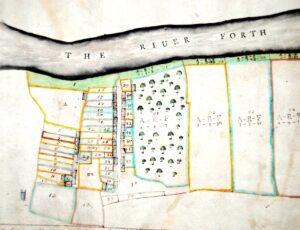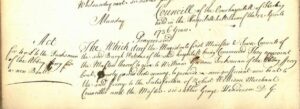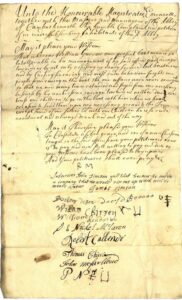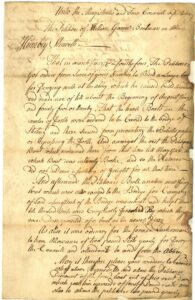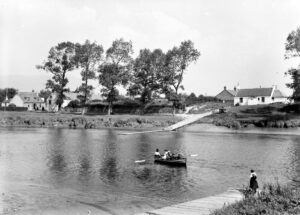Visit Scotland has extended Scotland’s Year of Coasts and Waters for another year, so for the first Document of the Month of 2021, we are once more focusing on the River Forth, which runs through so much of the Stirling Council area, and has helped shape the area’s history in many diverse ways.
The River Forth at Cambuskenneth is narrow enough to allow a ferry to cross easily. Originally, it is likely that the ferry crossing was put in place to provide access to Stirling for the monks of the Abbey there, founded by King David II in 1147. As the small settlement of Cambuskenneth grew, with its orchards and arable farmlands, traffic using the ferry is likely to have increased.
After the reformation, the Lands of Abbey, as Cambuskenneth was known, were administered on behalf of the Crown by the Erskine family, who were appointed Commendators of the Abbey of Cambuskenneth by Mary, Queen of Scots. Between the dissolution of the monastery and the early 18th century, this family oversaw all the tenancies on the lands around the village and would have been responsible for the running of the ferry.
In 1709, the Patrons of the Cowane’s Hospital Trust purchased the Lands of Abbey from Sir John Erskine of Alva, and the Trust took over the operation of the ferry service. The Council Archives has a plan of the property bought by the Trust that shows all of the buildings in the village at this time, including the Ferryman’s cottage at the end of South Street nearest the river. When the Ferryman was appointed, he was given the use of a cottage with a pendicle of land attached. The map also helpfully gives all the names of the inhabitants at this time. It would appear that at the time the map was drawn up, the Ferryman was one James Dickson.
There is much evidence of the Trust’s administration in their minute books. For example, an entry from the 12 August 1736, shows the Trust granting William Garrow, described as ‘tacksman of the Abbey ferry’ forty pounds Scots to buy ‘a sufficient new boat’. There are numerous other entries in the minutes relating to the ferry. You can find out more detail about this in a wonderful article about the ferry written by local historian and Cambuskenneth resident Mrs Linda Chapman.
There is a petition held at the Archives that was sent to Stirling Town Council and the Master and Patrons of the Cowane’s Hospital Trust in August 1739, complaining about the conduct of the ferryman at Cambuskenneth mentioned above. It is signed by 14 of the inhabitants and contains various accusations against William Garrow, the ferryman, for being rude, drunk and abusive. The text is given below: –
Stirling Burgh – Petitions to the Council 11th August 1739 Bundle 25/779/4
Unto the Honourable Magistrates & Counsell
together with the Masters and mannagers of the Abbey
of Cambuskenneth The humble complaint and petition
of us undersubscribing Inhabitants of the s[ai]d Abbey
– – – – – – – – – – – – – – – – – – – – – – – – – – – – – – – – – – – – – – –
May it please your Wisdoms
That whereas William Garrow our present boatman is so
Intollerable in his mannagement of his said office and Carriage
towards us by not only refusing us ready service but banters us
and by Cursing Swearing and most rude behaviour frights our
people from coming in the boat tho our affairs were never so urgent
so that we are many times retarded and stoped from our necessary
business by his unchristian cariage towards us neither do we
trust our children to go in the boat with him when we have
occasion to send them upon any necessary errand to the Town
except some of our selves be with our Children he is so rude
unnatural and always drunk and out of the way
May it therefore please your Wisdoms
to constitute a sober grave, and one of a more Christian
temper in the said office since your petitioners as use
is do pay and are still willing to pay our dues as
your Wisdoms have been pleased to lay upon us
And your petitioners shall ever pray &c
R M
Subscrives John Simson and that because he said in
a company that he would rip me up which will be
meade appear James Simson
Robert Dison David Boaard UF
William Chirrey AU
William Henderson
PS Nickel McLaren
Robert Callender
Thomas Chirrie
John McFarllend
PN EU
Despite this, it would appear that Garrow kept his job, as there is another petition in the Stirling Burgh collection made to the Burgh Council by William Garrow in 1753. In this, Garrow is asking for compensation for the fact that his boat was taken from him during the Jacobite Rebellion so that it could not be taken by rebels and used to cross the Forth and that the subsequent boat was similarly requisitioned to use to ferry sand for repairs to Stirling Old Bridge after the rebellion. Unfortunately, there are no accounts surviving for the Cowane’s Hospital trust for this date, but a note on the back of the petition seems to suggest the Trust was at least going to look into this.
In 1935, the ferry service was discontinued when the new footbridge was built over the Forth at this point in the river. You can read a detailed article about this on our blog here.
